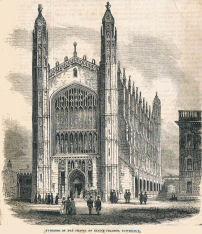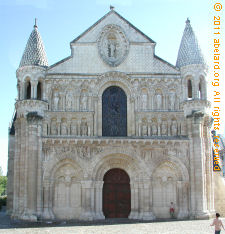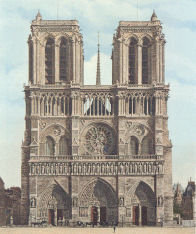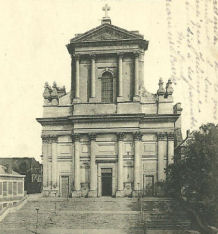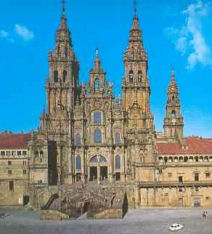


|
index
introductory
classifying the style of an Engish church
fan vaulting: an English phenomenon
ribs and bosses
some suggested religious buildings to visit in England
bibliography
end notes
England is a cold and windy land. Building high cathedrals with steeply sloping roofs is not fully suited to the battering they must endure through the centuries. Thus English churches tend to be built to lesser heights. England was a land of forests at least until the Tudors started turning them into battleships. In this land of very inventive and capable carpenters, naturally the churches would have wonderful and innovative churches, roofs and spires.
Unfortunately, the British weather, with its magnificent thunderstorms, provided plentiful lightening strikes, to which was added candle light and careless workers. Thus, fire was an ever-present annoyance and the threat remains in the age of computers and rockets to the moon. Many a church roof or spire still provide tinder boxes for the unwary. From about 1400 onwards, spires usually disappeared, whether from fashion or from fear I am unclear, hence the wonderful church towers that can be seen all over England. |
|

Manchester cathedral
Another generalised difference is that the churches were usually run as a part of monkish institutions, or even as an integral part of monasteries. Whereas in France, the towns were developing independence and the church could be a status symbol of the new, growing city. In English churches, non-clerics tended not to enter the east end of the church, and the unbaptised did not reach beyond the Galilee, while tradesmen and other secular folk could be seen by the monks in an area called 'the slype'.
The churches and monasteries of England tend to be low-built and the glass built to let in the, often dull, English light, using reams of plain glass and a few characterless saints for decoration.
Thus, the imagination went to detailing tracery patterns. Several examples can be seen at Stone tracery in church and cathedral construction.
Fashion became a considerable driver of patterns, which has often fascinated English writers attempting to trace the movements of particular architects and designers, and a change of tracery detail.
classifying the style of an Engish church
English train-spotters try to arrange their cathedral stamp collections into sections like the Norman style, the English style, the Decorated style, and Perpendicular. Sometimes, the Norman style is equated with the Romanesque, and the Decorated with the Flamboyant, all rather un-English. The established Norman or Romanesque style is defined by the use of the Roman or curved arch. This was surplanted by the pointed arch.
Of course, one so-called style changes into another over the years, as cathedrals accumulate their barnacles as their hundreds of years of development pass down the stream of life. Should you wish to become a stamp collector, a good place to start is Bell's English Cathedrals. There, for most English cathedrals, is set out a place to put each part of a cathedral into your album. For example, here is the layout for Durham cathedral:
Dedication: Saint Cuthbert. New foundation; formerly the church of a Benedictine monastery.
Distance from Newcastle by N.E.R. 15 miles.
Architectural styles of principal parts :
NORMAN. Nave, transepts, and choir.
TRANSITION. Galilee Chapel.
EARLY ENGLISH. Western towers.
EARLY DECORATED. Chapel of the Nine Altars.
PERPENDICULAR. Central tower.
- .
- NORMAN period or style
- the major:ity of 12th century, TRANSITIONing into
- EARLY ENGLISH
- the majority of 13th century, merging into
- DECORATED
- 14th century, finishing before the end of Edward III's reign in 1377.
- PERPENDICULAR
- from Richard II's reign (1377) to early Tudor times (late 15th century).
- .
The word 'transition' is used randomly by those who wish to complicate the cataloguing of their stamp albums. Thus, use of this word must be read in context of the various authors.
English cathedrals constantly tend towards the austere, or as the Puritan English mind would have it, the pure, simple and unadorned, or even boring. Some have suggested that the perpendicular style was influenced by the plain patterning of Islamic decoration, developed from ideas of returning crusaders. Then add in the iconoclasts, and the rather soul-less nature of English church presentation perhaps can be wondered at.
I am not very keen on this architectural jargon,
Renaissance [rebirth] architecture is usually regarded
as harking back to Greek and Roman styles, perhaps a reincarnation,
rather than a rebirth. The more fussy and complicated
a Renaissance building becomes, the more likely the use
of the word Baroque.
fan vaulting: an English phenomenon
[Also known as palm or conoidal vaulting.]

Fan vaulting in King's College, Cambridge
(spandrel outlined in pink, fans shaded in mauve)
The fans rise out of the side pillars, spreading their fingers out to provide a network of ribs that support the nave's roof in mutual tension. The fans rest against their neighbouring fans for support, that support being supplemented by the curtain arches and triangular spandrels above each window, and by the external buttressies.
Where the four fans meet, there is a lozenge-shaped space that is 'plugged' by a spandrel, a large manhole cover that provides lateral support to the upper edges of adjoining fans and prevents them collapsing under pressure at their top edge.
A spandrel is a three-dimensional version of a keystone in an arch.
"Spandrels has [sic.] an important role in providing compressive forces along the entire upper edge of conoid to keep the conoid in stress equilibrium which is important for a fan vault conoid in terms of structural strength ." (Walter and Leedy, 1978)
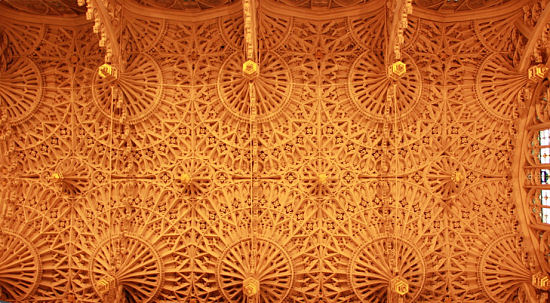
Henry VII Lady Chapel pendant fan vault, Westminster Abbey
"Pendant" vaulting is a later form of spandrel, often used in connection with fan vaulting, the illustrated example being from Westminster Abbey. Here, pendants are formed as elongated voussoirs that drop from a constructive pointed arch, concealed above the vaulting, forming abutments to support the pendant conoids.
Also note that the fans in the Lady Chapel, Westminster Abbey, extend from a form of hammer beam.
ribs and bosses
Ribs are primarily weight-bearing, curved columns of piped masonry, the armature [framework] of vaulting.
[See Net.]
However, particularly in England, where the perpendicular style developed, ceilings became far more decorative and complex. Ribs tend to be categorised with various labels including longitudinal, traverse, diagonal,
tierceron (in-between rib, from O.Fr. tiers, tierce; L; tertia - a third),
lierne (linking rib, prob. from M. Fr. lier - to bind; L. ligare - to tie).
Tierceron and lierne ribs are primarily decorative, not weight-bearing.
Very fancy ceilings (decoration) are often referred to as fan vaulting - variations of cones.
This part of the cathedral or church you will often hear called the roof, but it is not the roof, it is a ceiling.
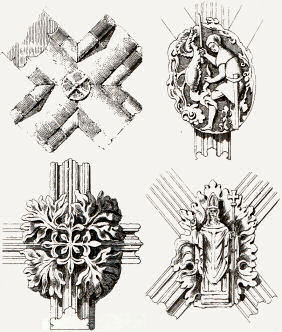
|
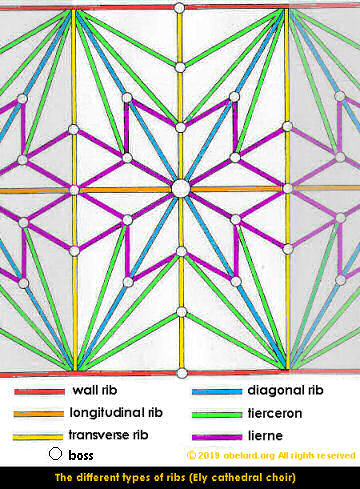 |
The joins between various ribs were usually covered by bosses of various artistic merit and complexity. Such bosses can be seen in Norwich, Exeter, Ely, Winchester, Hereford, King's College Chapel Cambridge, Gloucester, and many other cathedrals. Even fancier pendant vaulting can be seen at Canterbury and at Westminster. The bosses were, in part, used to cover the joins between ribs, but also developed as an art form.
These bosses have lasted rather better than much English church art, as the vandals of Henry VIII and Cromwell were less able to get at them, though the vandals did use muskets to damage or destroy the ceilings. Others used cross-bow bolts that ripped the lead protection on the roof and let the weather in, causing long-term damage.
In Norwich, there are over 150 bosses, often highly coloured. |
some suggested religious buildings to visit in England
- King's College chapel, Cambridge - the ultimate in perpendicular.
- Westminster Abbey, London - look up at the fan vaulting.
- Canterbury - the most Frenchified, runner-up is Westminster.
- Ely (Eely) - much to see.
- Durham - for very early Gothic and internal buttressing.
- Salisbury - due to being built during a short period, because the town was moved from Old Sarum. This was a new site and thus the cathedral is particularly unified.
- Wells - for its range of monastic buildings and its spectacular west front.
- St. George's Chapel, Windsor Castle - lots of fan vaulting in a late-medieval perpendicular Gothic style church.
bibliography
Fan vaulting: A study of form, technology, and meaning
by Walter C. Leedy, Jr. |
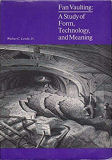 |
Arts + Architecture Press, pbk, California, 1980
ISBN-10: 0931228034
ISBN-13: 978-0931228032
amazon.com
amazon.co.uk |
|
An itinerary of the English cathedrals for the use of travellers
compiled by James G Gilchrist
by T. Perkins |
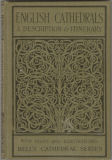 |
George Bell and Sons,
hbk, 2nd ed. 1905
Leopold Classic Library, pbk, 2016
ASIN: B01JLJGGQM
$12.95
£8.95 |
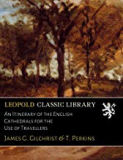 |
|
C.A. Hewett has put out three, steadily expanding versions of his book of cathedral carpentry.
- English cathedral carpentry, 1974
- English historic carpentry, 1980
- English cathedral and monastic carpentry, 1985
A life's enthusiasm.
A rough outline can presently be found here:
Wooden Octagonal Lantern Tower
of Ely Cathedral
[C.A. Hewett, English Cathedral Carpentry (London, 1974), pp. 82-9] |
English cathedral carpentry
by C.A. Hewett |
 |
Wayland publishers, hbk, 1974
ISBN-10: 0853403597
ISBN-13: 978-0853403593
amazon.com
amazon.co.uk |
|
The perpendicular style 1330 - 1485
by John Harvey |
 |
originally published by B. T. Batsford Ltd
HarperCollins Distribution Services, hbk, 1978
ISBN-10: 0713416106
ISBN-13: 978-0713416107
amazon.com
amazon.co.uk |
|
Heavenly Vaults: From Romanesque to Gothic in European Architecture
by David Stephenson |
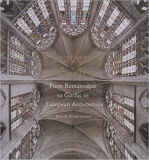 |
Princeton Architectural Press, hbk, 2009
ISBN-10: 1568988400
ISBN-13: 978-1568988405
amazon.com
amazon.co.uk |
end
notes
-
- Until very recently, the roofs of the great cathedrals
were framed in massive and complex
structures of wood, often known as ‘the forest’.
-
Due to its vulnerability to fire, the ‘forest’
has been a great bane for gothic cathedrals from the
earliest times. This regularly caused much damage to
the cathedral at large, by damaging the stone work,
as well as setting
fire to the cathedral structure and furnishings.
See the fire at the cathedral of Notre-Dame de Paris.
Now, restoration is turning to reinforced concrete
for roof framing as, for instance, at Noyon. Iron and steel has also been used on occasion in the past (see Chartres - roof space: le charpente de fer).
-
- piped
- The columns that are carved decoratively to give the appearance of a bunch of thinner columns are often called piped columns or masonry. Why? Because the result does look like a clump of pipes standing on end.
|











